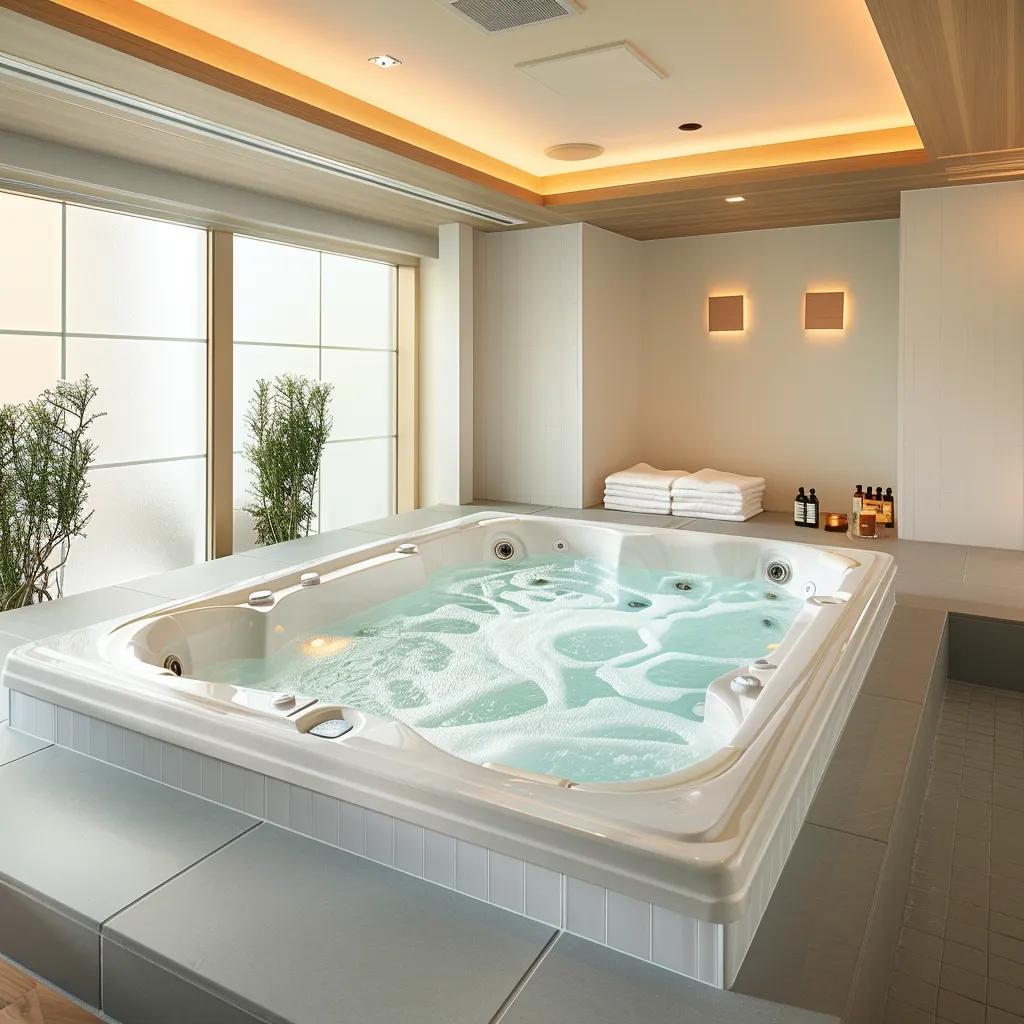Table of Contents - Test Your Hot Tub Water: Achieving Quality and Safety
- What Are Hot Tub Water Test Kits and Why Are They Essential?
- How Do You Prepare to Test Your Hot Tub Water Accurately?
- What Is the Step-by-Step Process to Use Hot Tub Water Test Kits?
- How Do You Interpret Hot Tub Water Test Results for Safety?
- How Can You Troubleshoot Common Hot Tub Water Chemistry Problems?
- How Do You Maintain Hot Tub Water Quality After Testing?
- What Are the Benefits of Using Digital Hot Tub Water Testers Compared to Other Kits?
- Frequently Asked Questions
- Final Thoughts
This blog post may contain affiliate links. As an Amazon Associate I earn from qualifying purchases.
Hot tubwater quality is vital for a safe, comfortable spa experience. Inaccurate readings or imbalanced water chemistry can lead to skinirritation, equipment damage, and bacterial growth. Reliable hot tubwater test kits allow spa owners to monitor critical parameters—pH, alkalinity, sanitizer levels, calcium hardness, and more—with quick, accurate, and user-friendly methods.
This guide explains how to Test your hot tub water, what hot tubwater test kits are, the available types, and why they are essential. It also provides a concise step-by-step process for using these kits correctly, interpreting the results, troubleshooting common chemistry issues, and maintaining long-term water quality.
This comprehensive guide includes clear instructions, real-world examples, and data-backed explanations to highlight the importance of precision in watermeasurement. By the end, you will understand how to balance your hot tubwater for a better spa experience.
What Are Hot TubWater Test Kits and Why Are They Essential?
Hot tubwater test kits are specialized tools that measure key chemical parameters in spa water. They provide a quick, accurate, and user-friendly method to ensure water safety for users and protect spa equipment. By detecting imbalances in pH, alkalinity, or sanitizer levels (chlorine or bromine), these kits help prevent costly repairs and health hazards.
Test kits come in various formats including test strips, liquidreagent (titration) kits, and digital testers equipped with photometric sensors. Each method is calibrated to detect precise chemical levels. Maintaining a balanced hot tubwater environment minimizes risks such as corrosion, scaling, and irritation. For example, keeping pH within a 7.2–7.8 range prevents discomfort and damage. Regular testing enables early detection of issues like sudden drops in sanitizer levels or rising calcium hardness, allowing for prompt chemical adjustments and effective spa water treatment.
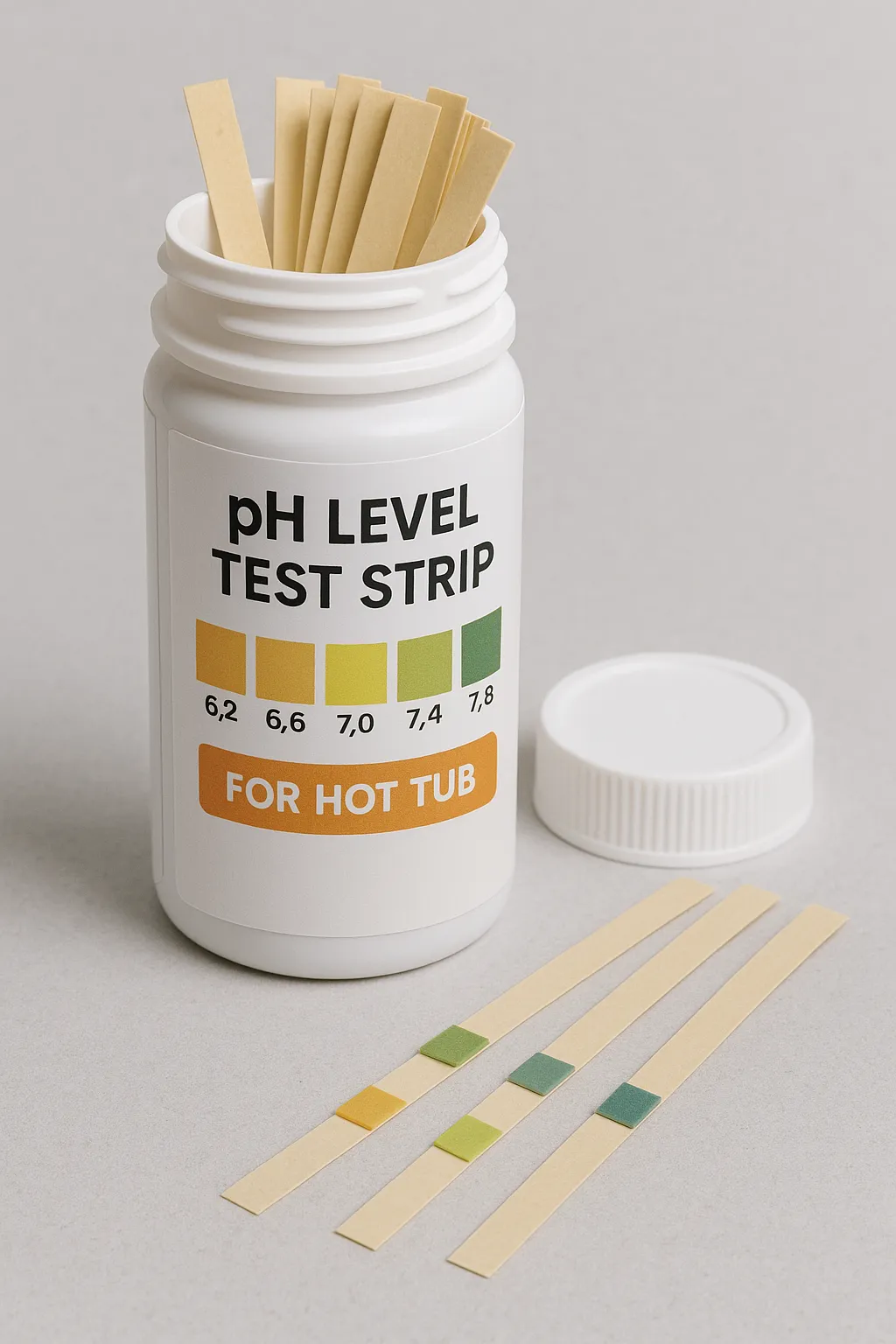
What Types of Hot TubWater Test Kits Are Available?
- Test Strips – The most common option due to ease of use and rapid results. Simply dip a reagent-impregnated strip into the water and compare the resulting color to a chart. While ideal for quick weekly checks, test strips may be less precise and sometimes require calibration with a more accurate method.
- Liquid Reagent Kits (Titration Kits) – These kits involve adding reagents drop-by-drop to a measured water sample until a color change signals the endpoint. Though more time-consuming, they offer high accuracy and are excellent for determining exact alkalinity and calcium hardness levels—key for preventing scaling and corrosion.
- Digital Hot Tub Water Testers – Modern devices that use electronic sensors and photometric technology (often with Bluetooth connectivity) to deliver real-time, precise water data. They are well-suited for continuous monitoring, with the capability to store historical data for trend analysis, making them popular in upscale spas and commercial settings.
Each kit type has unique advantages; your choice depends on your need for precision and ease of monitoring. Use test strips for regular checks, liquid kits for detailed monthly analyses, and digital testers for ongoing monitoring.
How Do Hot TubWater Test Kits Ensure Water Quality and Safety?
These kits work on the principle of chemical reactions. When reagents interact with chemicals in the water, a color change or electronic signal occurs that correlates to the concentration of a parameter (for example, pH or sanitizer level). Whether using color-matching with test strips or sensor data on digital devices, these measurements indicate if the water is balanced.
Unbalanced water can promote bacterial growth and cause irritation to skin and eyes. For instance, if pH is measured at 7.0 instead of the ideal 7.4, appropriate chemicals can be added immediately. High-quality test kits also feature calibration functions to ensure accurate, reliable results over time. In short, hot tub test kits bridge the gap between manual oversight and automated monitoring to keep the water hygienic, balanced, and safe.
What Are the Key Water Quality Parameters Tested?
To ensure optimal enjoyment and safety, it is essential to regularly test your hot tub water.
Key parameters include:
- pH Level – Ideal hot tub water pH is 7.2–7.8. Levels below 7.2 are too acidic (risking corrosion and skin irritation), while levels above 7.8 are too alkaline (reducing sanitizer effectiveness).
- Alkalinity – This buffer stabilizes pH and should be maintained between 80 and 120 parts per million (ppm). Proper alkalinity prevents rapid pH changes due to environmental factors or bather load.
- Sanitizer Levels (Chlorine/Bromine) – For chlorine, aim for 1–3 ppm; for bromine, 3–5 ppm. These ranges are sufficient to neutralize pathogens without causing irritation.
- Calcium Hardness – Measuring dissolved calcium is crucial. Levels should generally fall between 150 and 250 ppm—too low can lead to corrosion; too high may cause scaling.
- Additional Parameters – Some advanced kits test for phosphates, total dissolved solids (TDS), and cyanuric acid. Phosphates, for example, can interfere with sanitizer effectiveness.
Each parameter plays a role in preserving water quality and extending spa equipment longevity. With balanced pH and alkalinity, sanitizers work more effectively, reducing the risk of contamination.
How Do You Prepare to Test Your Hot TubWater Accurately?
Preparation is critical for reliable test results. Ensure you have the right tools and follow a systematic process before sample collection.
What Supplies and Tools Do You Need for Testing?
Gather these essentials: – Hot Tub Water Test Kit: Choose from test strips, liquid reagent kits, or a digital tester. – Clean Container: Use a disposable or thoroughly cleaned container to avoid contamination. – Protective Gloves: To prevent chemical contact and sample contamination. – Instruction Manual/Reference Chart: Essential for accurate interpretation. – Notebook or Digital Device: To record results and track trends over time.
Using these supplies correctly prevents cross-contamination and ensures precise readings.
When Is the Best Time to Test Your Hot TubWater?
Test when the tub is at its regular operating temperature (around 100°F to 104°F) and under normal use conditions—ideally 30 minutes to an hour after adding any chemicals. Routine testing, ideally once or twice a week (or after heavy use), helps maintain consistent water chemistry.
How Should You Collect a Water Sample for Testing?
Follow these steps: – Turn off any water jets or recirculation to minimize bubbles. – Collect a sample from the mid-level of the tub to avoid surface films or bottom residues. – Choose a spot away from any recent chemical additions for an accurate overall composition. – Test the sample immediately to prevent any alteration in chemical balance.
This careful collection process ensures the sample accurately reflects the tub’s condition.
What Is the Step-by-Step Process to Use Hot TubWater Test Kits?
Follow a systematic process to ensure accurate measurements and identify potential issues:
How to Use Hot Tub Test Strips Correctly?
- Immerse the test strip in the water sample for the recommended 10–15 seconds.
- Tap off excess water gently without shaking.
- Immediately compare the colors on the strip to the provided chart (within 30 seconds).
For improved accuracy, take multiple readings and average them. This method is ideal for routine checks.
How to Perform Tests With LiquidReagent Kits?
- Fill a clean test tube or container with a measured water sample.
- Add reagent drops slowly while stirring gently.
- Observe the color change until the endpoint is reached, as indicated by the kit’s chart.
- Record the number of drops used, which translates directly to the chemical level being tested.
This titration method offers enhanced precision, especially for parameters like alkalinity and calcium hardness.
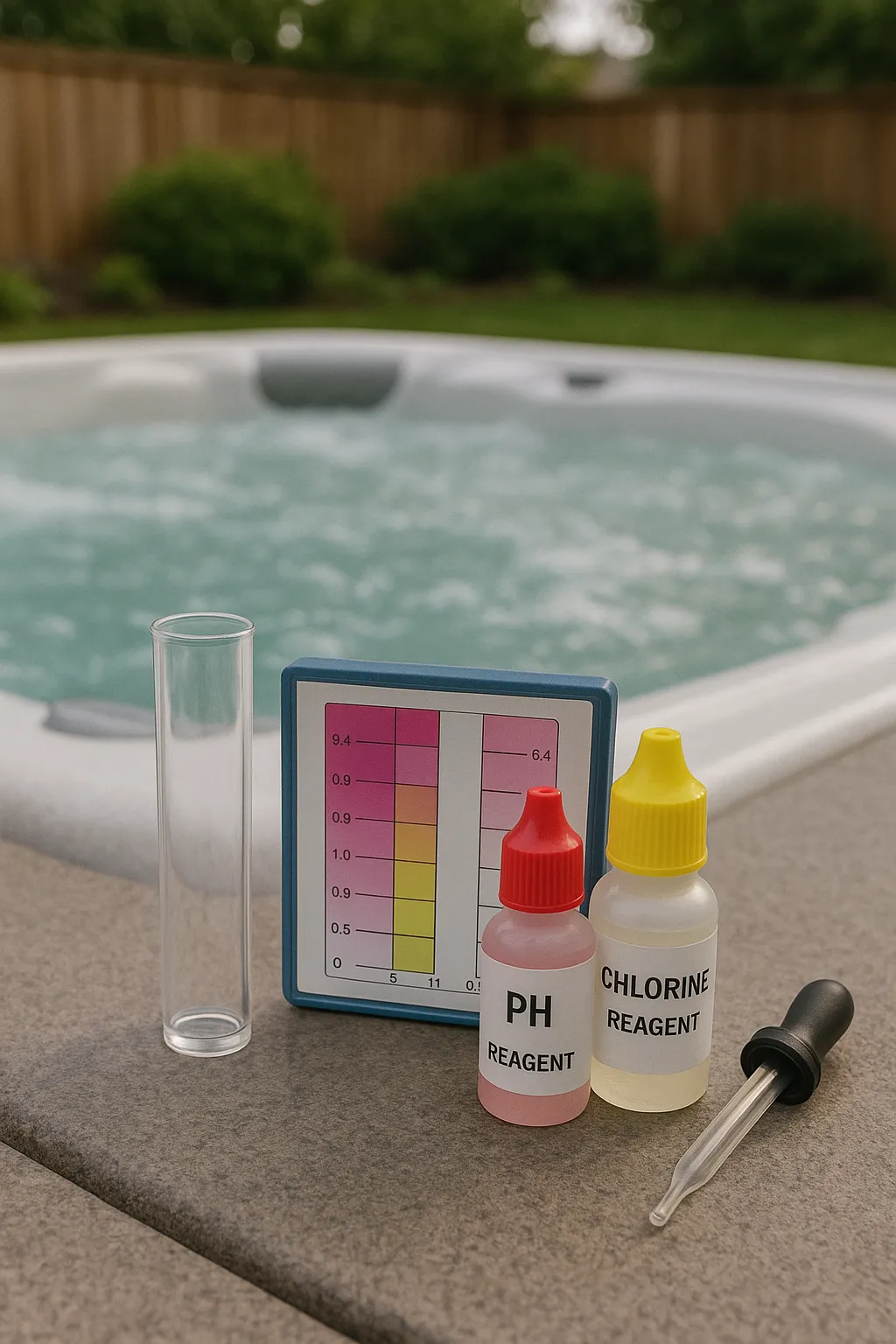
How to Operate Digital Hot TubWater Testers?
- Calibrate the digital tester following the manufacturer’s instructions.
- Immerse the sensor fully in the water sample, ensuring it is free from bubbles or debris.
- Activate the device to display real-time readings (e.g., pH, sanitizer levels, temperature).
- After use, clean the sensor to prevent residue buildup for future tests.
Digital testers offer convenience and accuracy with features such as data logging for trend analysis.
How to Record and Track Your Test Results?
Maintain a log—either in a dedicated notebook or digital spreadsheet—to record: – Date and time of testing – pH, alkalinity, sanitizer levels, calcium hardness readings – Ambient conditions and bather load, if applicable
Regular tracking helps detect early imbalances and aids in adjusting chemical dosages.
How Do You Interpret Hot TubWater Test Results for Safety?
Correctly interpreting test results ensures your hot tubwater is balanced and safe without you having to ask “how often should I change my water?“. Each parameter has an ideal range that supports both the longevity of your equipment and the comfort of its users.
What Are the Ideal pH Levels for Hot TubWater?
The target pH is 7.2–7.8. Readings below 7.2 indicate high acidity, risking corrosion and skinirritation; readings above 7.8 indicate high alkalinity, which may cause scaling. Consistent monitoring and adjustment with pH increasers or decreasers help maintain this balance. You can find more information on the best practices for managing pH levels in your hot tub throughout.
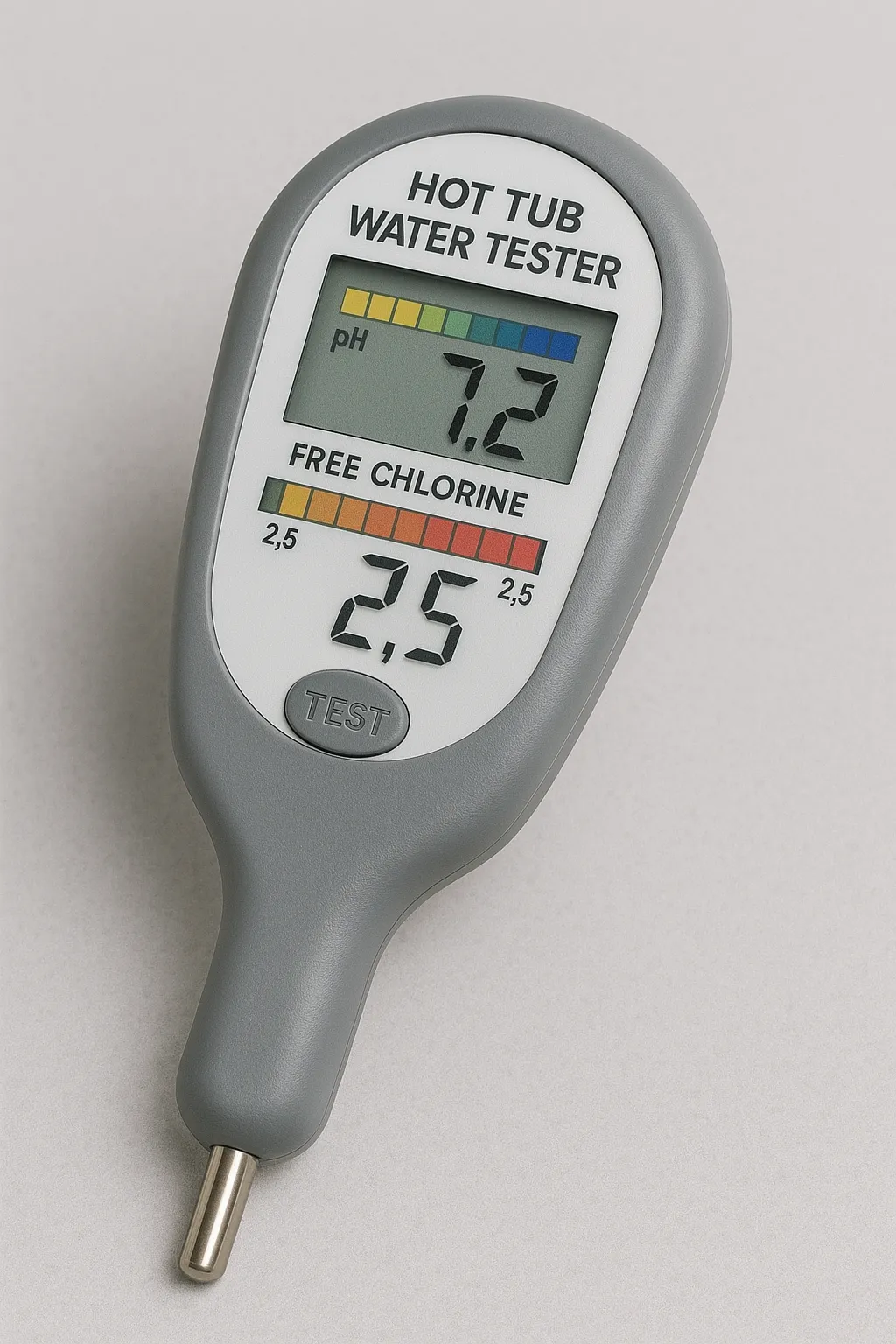
How to Understand Alkalinity and Its Impact?
Total alkalinity, ideally 80–120 ppm, buffers against rapid pH changes. Low alkalinity can lead to erratic pH levels, while high alkalinity can sustain elevated pH values. Adjusting with sodium bicarbonate or appropriate acids can stabilize water chemistry and enhance sanitizer performance.
What Are Safe Sanitizer Levels (Chlorine, Bromine) in Hot Tubs?
For effective disinfection without irritation: – Chlorine: 1–3 ppm – Bromine: 3–5 ppm
Regular testing is essential; if levels drop, add more sanitizer, and if they exceed safe limits, allow time for dissipation or partially drain and refill the tub.
Why Is Calcium Hardness Important and How to Read It?
Maintain calcium hardness between 150 and 250 ppm. Too low, and water becomes corrosive; too high, and scaling forms on surfaces and heating elements. Use a calcium increaser or sequestering agents as needed, and retest to ensure the values stay within range.
How Can You Troubleshoot Common Hot TubWater Chemistry Problems?
Troubleshooting involves identifying issues from test results and taking corrective actions for pH, alkalinity, sanitizer, or calcium hardness imbalances.
What to Do if pH Levels Are Too High or Too Low?
- If pH is above 7.8: Add a pH decreaser (e.g., muriatic acid or sodium bisulfate) gradually while rechecking levels.
- If pH is below 7.2: Use a pH increaser (often soda ash) and retest after 30 minutes.
Gradual adjustments and frequent retesting help avoid overshooting the desired pH range.
How to Correct Alkalinity Imbalances?
- To raise alkalinity, add sodium bicarbonate slowly while stirring.
- To lower high alkalinity, add a measured amount of acid.
Small, incremental adjustments paired with periodic testing keep alkalinity within 80–120 ppm.
How to Manage Sanitizer Level Issues?
Monitor sanitizer levels frequently. If below range, add the appropriate sanitizer dose; if too high, consider dilution or allowing natural dissipation. Consistent testing is key to ensuring the water remains disinfected without harmful overexposure.
How to Address Calcium Hardness Problems?
- Low calcium hardness: Add a calcium increaser to protect metal components.
- High calcium hardness: Use sequestering agents or dilute with fresh water having lower mineral content.
Regular retesting is essential to maintain the right balance and prevent both corrosion and scaling.
How Do You Maintain Hot TubWater Quality After Testing?
Maintaining water quality is an ongoing process. Continue to balance chemicals, perform shock treatments, and follow a consistent maintenance schedule to reduce risks of bacteria, scale buildup, and corrosion.
What Is the Best Way to Balance Hot TubWater Regularly?
Establish a routine for testing and adjusting chemical levels: – Immediately address any deviations from ideal pH, alkalinity, sanitizer, or calcium hardness levels. – Combine weekly or bi-weekly tests with daily visual inspections. – Clean filters and monitor for residue buildup to catch issues early.
When and How Should You Shock Your Hot TubWater?
Shocking increases sanitizer concentration to oxidize contaminants: – Perform shock treatments after heavy use or when organic buildup is detected. – Use the manufacturer’s recommended oxidizer dose, then wait approximately 24 hours before retesting.
What Is an Effective Hot TubWater Maintenance Schedule?
Develop a schedule that includes: – Daily: Visual inspections and sanitizer level checks. – Weekly: Testing pH, alkalinity, and other key parameters. – Monthly: Comprehensive cleaning of filters and deep shock treatments.
A well-documented logbook of these routines helps you track trends and plan proactive chemical adjustments.
What Are the Benefits of Using Digital Hot TubWater Testers Compared to Other Kits?
Digital testers offer enhanced accuracy and ease of use through modern sensor technology and user-friendly interfaces, making them an efficient alternative to traditional methods.
How Do Digital Testers Improve Accuracy and Ease of Use?
Digital testers provide precise readings using calibrated electronic sensors and photometric analysis with minimal human error. They deliver real-time data, support historical logging, and often feature Bluetooth connectivity for monitoring trends via mobile apps.
What Are the Common User Reviews and Ratings for Digital Testers?
Users appreciate digital testers for their consistent accuracy, clear displays, rapid response times, and the convenience of automated data logging. These features simplify routine maintenance and provide peace of mind that water chemistry remains balanced.
How to Choose the Right Hot TubWater Test Kit for Your Needs?
Your choice should balance accuracy, ease of use, and cost. Consider digital testers for continuous, precise monitoring if budget allows. Alternatively, test strips and liquidreagent kits are viable for less frequent testing. Evaluate factors like your hot tub’s usage frequency, water chemistry complexity, and desired accuracy to select the best option.
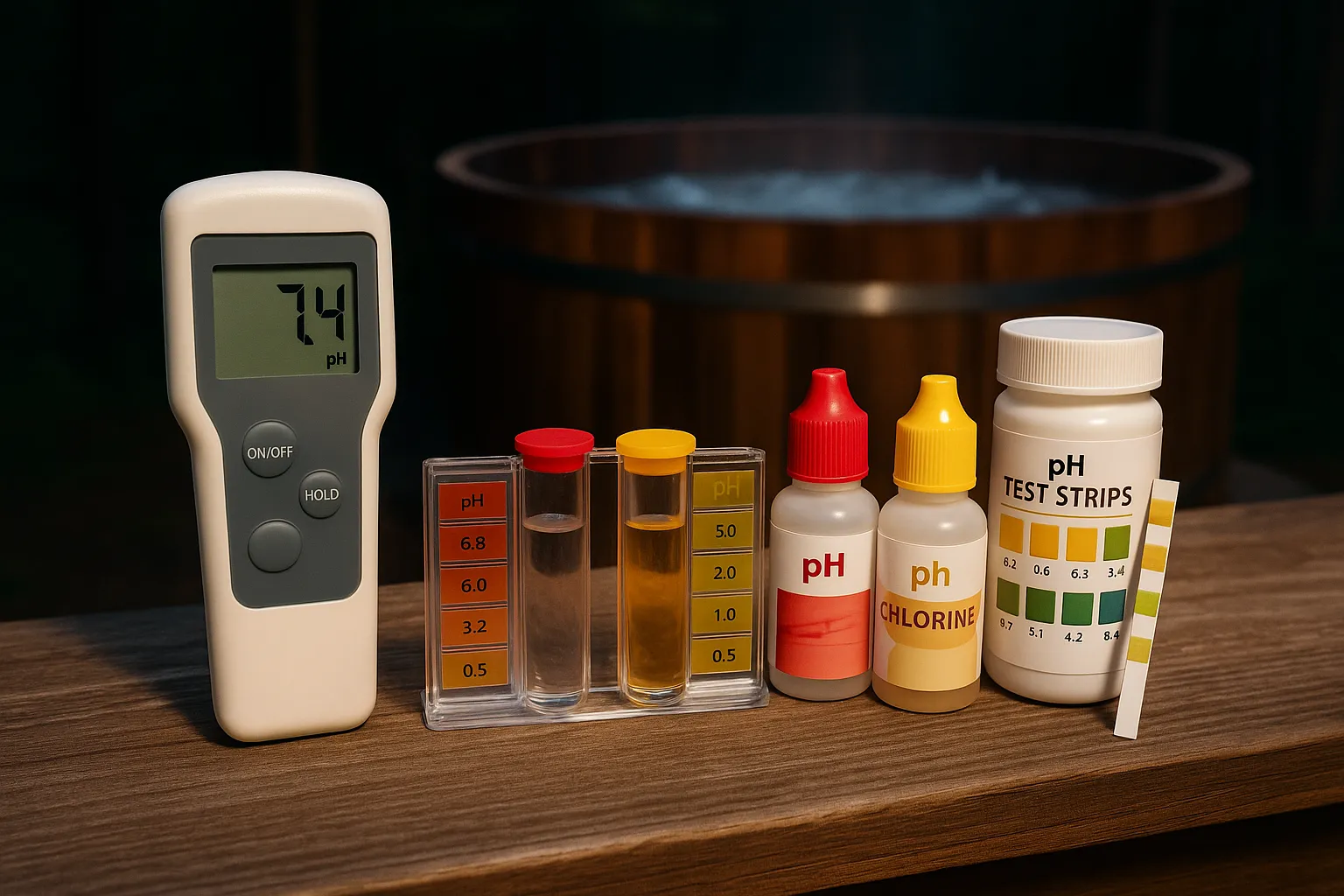
Frequently Asked Questions
Q: How often should hot tub water be tested? A: Test at least once or twice a week, and more frequently after heavy usage or large gatherings to ensure chemical balance.
Q: Can I use pool test kits for my hot tub? A: It is best to use kits designed for hot tub water chemistry, as optimal ranges and parameters can differ from swimming pools.
Q: What should I do if my hot tub water appears cloudy? A: Cloudy water typically signals a chemical imbalance or high organic load. Shock the water, check sanitizer levels, and adjust pH and alkalinity as needed. Regular maintenance usually prevents this issue.
Q: Are digital hot tub water testers more expensive than traditional kits? A: Yes, digital testers generally have a higher initial cost. However, their superior accuracy, ease of use, and long-term savings from preventing costly repairs can justify the investment.
Q: How do I calibrate my digital hot tub water tester? A: Calibration methods vary by model. Follow the manufacturer’s instructions, which typically involve using calibration solutions to set the device to known values. Regular calibration is necessary to maintain accuracy.
Q: What steps can be taken to prevent common water quality issues? A: Routine testing, a strict maintenance schedule, regular filter cleaning, and prompt chemical adjustments are key. Using a digital tester with logging capabilities can help spot trends early.
Q: Can my hot tub water test kit measure all the chemicals needed? A: Most comprehensive kits measure pH, alkalinity, sanitizer levels, and calcium hardness. Advanced kits may also test for phosphates and total dissolved solids. Always choose a kit that meets your spa’s specific needs.
Final Thoughts
Hot tubwater test kits are essential tools for maintaining balanced, safe, and inviting spa water. Regular use combined with precise testing, careful interpretation, and timely chemical adjustments helps prevent problems like bacteria growth, corrosion, and scaling. By following a robust maintenance schedule—including digital testing, record keeping, and periodic shock treatments—spa owners can extend the life of their equipment and enjoy optimal water quality. Integrating these practices into your routine will ensure a consistently superior hot tub experience for both home and professional settings.


